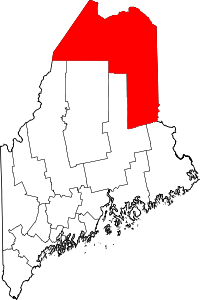Aroostook Band of Micmac
The Aroostook Band of Micmac is a federally recognized tribe of Mi'kmaq people in Aroostook County, Maine.[1] Their autonym is Ulustuk. Of the 28 bands of Mi'kmaq people, the Aroostook Band is the only one in the United States, and the Aroostook Band were the first non-US power to sign a treaty with the United States on July 6, 1776.[3]
| Total population | |
|---|---|
| 1,110+[1] | |
| Regions with significant populations | |
| Languages | |
| English, Mi'kmaq | |
| Religion | |
| Roman Catholicism,[2] traditional tribal religion | |
| Related ethnic groups | |
| Other Mi'kmaq people |
The tribe has no reservation but owns 1,350 acres (5.5 km2) of land.[3] The United States Census Bureau listed 1,047 acres (4.236 km2) of Trust Land in the 2010 United States Census, located at 46°55′13″N 67°53′15″W in the Town of Limestone. An official population of 197 inhabitants was counted on the trust lands. The band is headquartered in Presque Isle, Maine. The governing council consists of nine members that serve two-year terms.[4]
History
The Aroostook Band of Micmac in northern Maine forms part of a large Algonquian-speaking nation, known as the Mi'kmaq. Their ancestral homeland reaches as far northeast as Newfoundland and historically includes Cape Breton Island, Nova Scotia, Prince Edward Island, a large part of New Brunswick, and a small part of Quebec in the Chaleurs Bay area. Their name is thought to be based on the indigenous term nikmaq ("my kin friends"), referring to allies. Until the 1990s, the Aroostook Band formed a landless (off-reservation) and dispersed community. Families made a living as basketmakers, loggers, and seasonal farm laborers.[5] The Aroostook Band were excluded from the 1980 Maine Indian land claim settlement.[2] On November 26, 1991, they gained federal recognition when the Aroostook Band of Micmacs Settlement Act was passed as law.[1] In 1991, the tribe had almost 500 members.[2]
Art
Members of the Aroostook Band weave black ash baskets, quillwork birch bark boxes, and floral sculptures from maple, cedar, and white birch wood.[1]
References
- "Introduction." Aroostook Band of Micmacs. 5 March 2012. Retrieved 1 May 2013.
- Pritzker, p.435.
- "Region 1 Tribal Program" Region 1: EPA New England."
- "Election Ordinance" (PDF). Aroostook Band of Micmacs. 2003.
- Prins, Harald E.L. "Tribal Network and Migrant Labor: Mi'kmaq Indians as Seasonal Workers in Aroostook's Potato Fields (1870-1980)." In Native Americans and Wage Labor: Ethnohistorical Perspectives, pp. 45-65, 274-76. Alice Littlefield and Martha Knack, eds. Norman: U. of Oklahoma Press, 1996.
Sources
- Pritzker, Barry M. A Native American Encyclopedia: History, Culture, and Peoples. Oxford: Oxford University Press, 2000. ISBN 978-0-19-513877-1
